JULY 2017
Vixen 2.1 x 42 mm Wide Field Binoculars: Review
[This is just one of many articles in the author’s Astronomy Digest.]
This one of many articles in the Author’s Astronomy Digest.
A number of manufactures including Vixen produce a pair of binoculars having an objectives of around 42 mm diameter and magnifications just greater than 2. Vixen co-developed their version, the SG 2.1×42 binoculars, with Miyauchi in Japan (one of the world’s leading binocular manufacturers) and put them on the market in 2014. I must admit that I was not aware of them, or of other similar models, until I recently spotted a full page advert for one of the competing makes and was rather surprised by its specification. I thus began to research them on the web and became aware of the Vixen version which I was able to order from First Light Optics for £259 (July 2017) and which arrived the following morning.
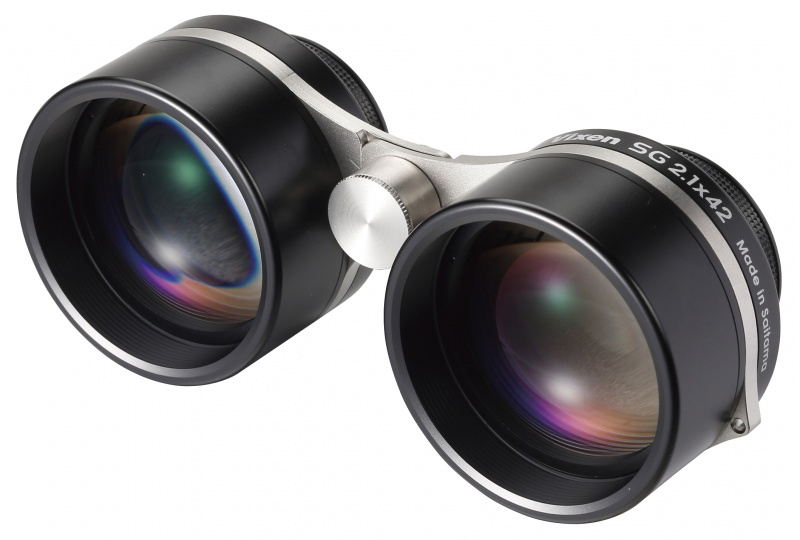
The Vixen/ Miyauchi SG 2.1×42 binoculars
In the context of this review I would point out that, at first sight, the large aperture objectives are a little misleading. The binoculars will give an exit pupil of 20 mm diameter and so only a small proportion of the collected light will actually enter the eye. The effective aperture of these binoculars is the dark adapted pupil diameter times 2.1 so, for a 6 mm aperture pupil, will be just over 12 mm. But this still gives a useful increase in sensitivity as your effective pupil area is increased by 2.1 squared, or 4.41, and this would give a magnitude increase of 1.61 − say ~1.5 to cover any transmission losses in the binoculars. One’s eyes (if young) might then have a limiting magnitude of ~7.5 rather than ~6 under dark transparent skies, so you will see significantly more stars than with the unaided eye. Under light polluted skies, one might observe a greater increase in magnitude as discussed in the first addendum at the end of the essay.
But there is a reason for using the 42 mm diameter objective lenses. The binoculars use a Galilean optical system (as in opera glasses) with a concave eyepiece providing a non inverted image. Perhaps surprisingly, the actual field of view then scales linearly with objective diameter. So, if the objective diameter is doubled, the real field doubles. As the pupil is placed closer to the eyepiece the field of view increases so, providing one does not suffer too greatly from astigmatism it would be best to use them without glasses. Significantly for this usage, focusing is independent for each eye so that one can compensate for differing lens prescriptions − though one might not be able to focus on infinity (important!) if one is myopic and the lenses are too strong. My tests indicate that one should be able to achieve infinity focus for myopic eyes which have a prescription of up to around -3 dioptres. Observations when not wearing glasses indicate a field of view of ~28 degrees. Below are two indications of the field of view I obtained observing at midnight in July 2017.
This agrees with my measurements and ‘inverse tan’ calculations when observing a nearby test object.
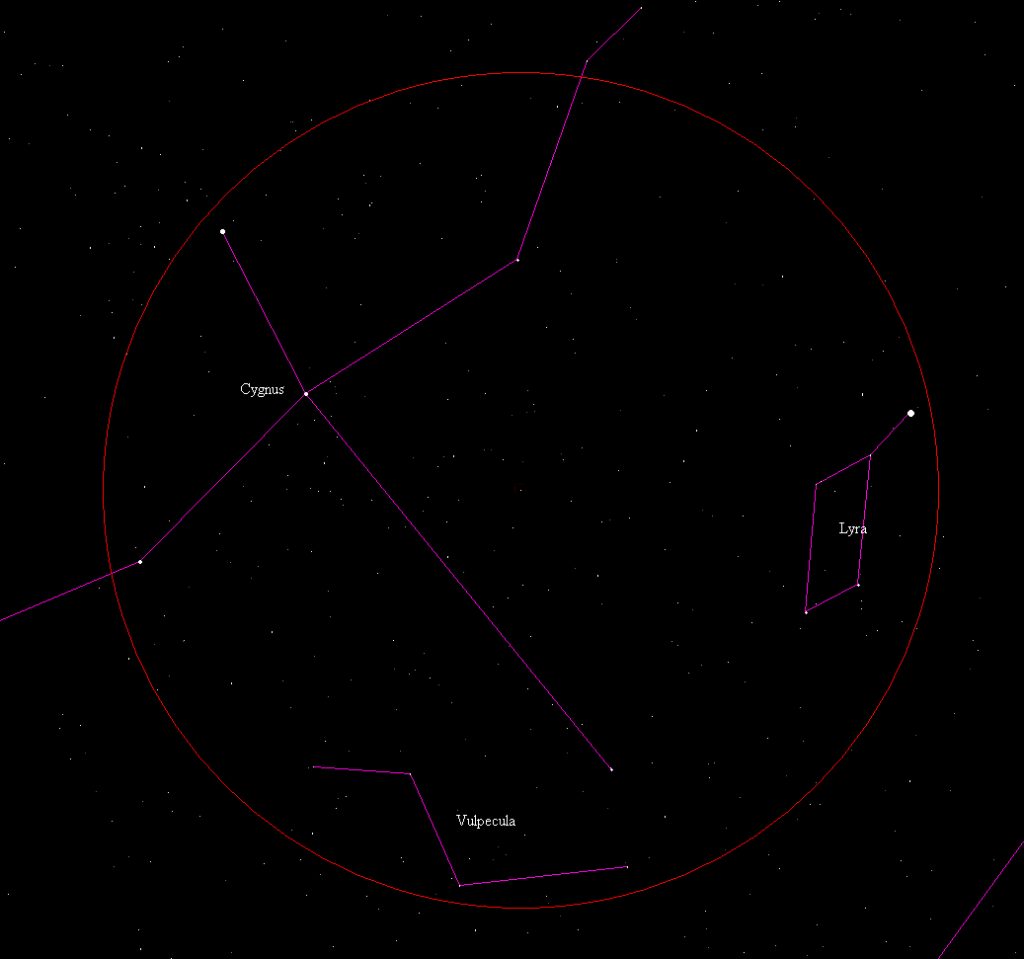
The field of view without wearing glasses looking towards Cygnus and Lyra
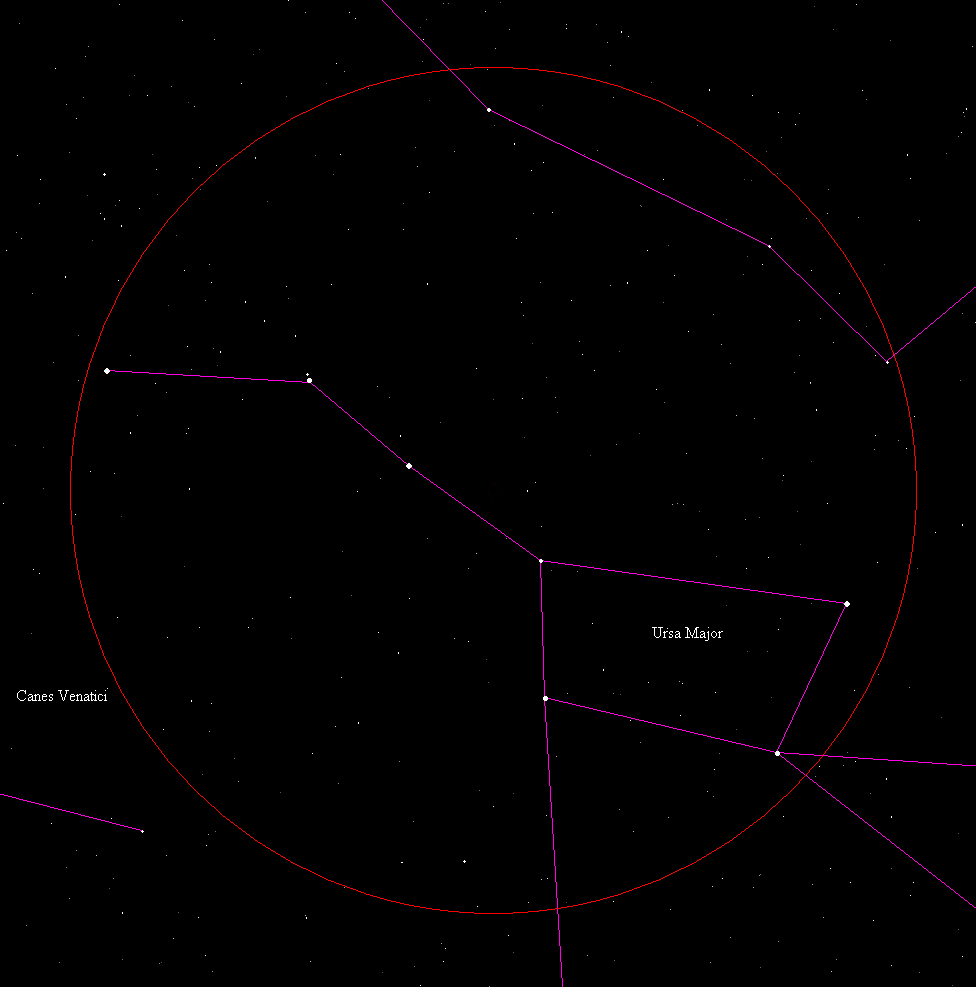
The field of view without wearing glasses looking towards the plough
Observations when wearing glasses indicate a field of view of ~22 degrees − still pretty impressive. There is, however, a real difference beyond the reduction in the field of view. When wearing glasses one is aware that one is using a pair of binoculars but without them this is far less obvious and, in daylight, one feels that one is just seeing a brighter and clearer view of the world and the binoculars seem to disappear. They are, however, quite heavy for their size which, I think indicates the quality of their manufacture. It is not too obvious that the view is magnified either.
Not surprisingly, the image quality falls off towards the edge of this very wide field with perhaps the central 12-14 degrees having the highest quality. But, of course, due to the size of the fovea where the cones are concentrated and the eye provides its best resolution, beyond this angular diameter the resolution of the eye is falling off as well and I do not find this too noticeable. The important thing to learn is not to move one’s eyes to search across the field of view to any great extent, but to keep them aligned with the optical axis of the lenses (and so observing the sharpest region of the field − which really is very sharp and has very high contrast) and move one’s head to point the binoculars towards the region of interest. Incidentally, unlike an eyepiece, Gallilean opera glasses do not have a well defined field stop, which would give a nice sharp black circle framing the field of view, but one sees instead the out-of-focus periphery of the objective lens. This helps to explain why the field of view is determined by the diameter of the objective lens.
Enabling their use without glasses for strongly myopic (short sighted) eyes
The sight in one of my eyes at night is just beyond what can be compensated for by focussing so I really need to wear glasses. [See the addendum on ‘night myopia’ below.] But, as described above, the use of these binoculars is more satisfying when glasses are not used. I thus investigated the possibility of obtaining a small concave correction lens to locate very close to the eyepiece so that I would not to have to wear glasses and hence allow my pupils to get close to the eyepiece and give the full available field of view.
I discovered that Fujifilm produce small dioptre (or diopter) correction lenses at plus or minus 1, 2 or 3 dioptres for ~£15 and which can be bought from Park Cameras. These, mounted in a metal ring are 20 mm in diameter and will just locate centrally in the depression at the rear of the objective. In position, they project upwards by 3 mm, but this is of no consequence as the shape of the eye socket limits how close one can bring the pupil towards the eyepiece. Ideally one would purchase one that would just give the additional correction required, in my case -1 dioptre. However, these were not in stock and I had to acquire a -3 dioptre lens. With this lens in place I was still able to adjust the focus sufficiently when using my glasses. One could perhaps glue the lens in place, but I have simply used a thin ring of ‘blu tack’ which has worked very well.
Specification
The binoculars come with a padded case, lens caps and a neck strap so that they will not fall and be damaged should one drop them from one’s hand.
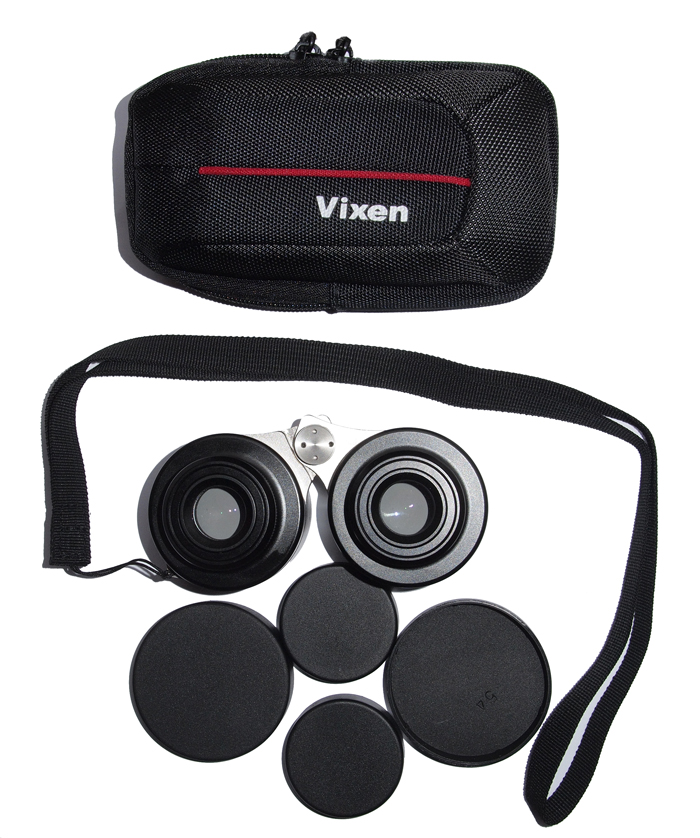
Binocular Specification
Magnification 2.1x
Diameter 42 mm
Coatings Fully multi-coated
Close focus 2 metres
IPD 55 to 74 mm
Size 4.6 × 12.8 × 5.4cm
Weight 410g
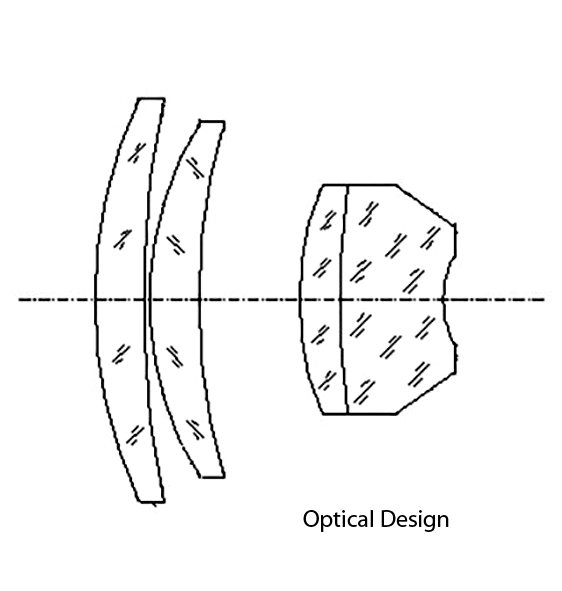
The lenses are superbly multi-coated and the internal surfaces are both ridged and blackened – both of which help give the binoculars their very high contrast. I have not included the numbers Vixen give for the field of view or eye relief as these do not really apply well to Galilean binoculars.
These binoculars can give very impressive wide field views of the heavens, as demonstrated above, encompassing the whole of the plough (25 degrees across) at one time or the full extent of Gygnus from Deneb down to Albireo (22 degrees apart) and even including the constellation Lyra. On a really dark transparent night one should be able to spot the North America Nebula. Again, all the bright stars in Orion will be seen in one field of view (they encompass 19 degrees) with the Orion Nebula showing as a hazy spot. I have imaged from New Zealand what is perhaps the most beautiful part of the southern Milky Way centred on the Southern Cross and the Coal Sack Nebula (there is a post in the digest describing the taking of this image) and I am very much looking forwards to observing this region through these binoculars.
Craters at the limb of the moon can just be seen and its mare regions show up more clearly. OK, these binoculars are not really for viewing the Moon and certainly not the planets − but there is, perhaps, one exception. There is the interesting question as to whether our unaided eyes can observe the phase of Venus. I cannot, but some, with exceptionally acute eyesight, can see its very thin phases (when the angular size approaches 1 arc minute) during twilight. One should be able to observe the phase using these binoculars.
An interesting exercise is to observe the stars within the body of the plough. With the unaided eye one might not spot any − the brightest is at magnitude 5.27. There are 4 stars in the magnitude range 5-6 (one is fractionally outside the body) and a further 7 in the magnitude range 6-7. There are thus 11 that one should certainly be able to spot using these binoculars when the plough is high in the sky. There are a further 8 in the range 7 to 7.5 magnitudes so that young eyes might well spot up to 19 stars under dark, moonless, skies.
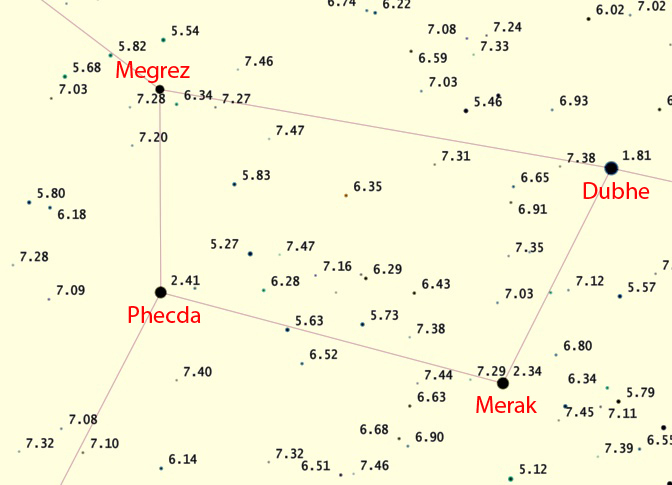
Stars within the body of the Plough
Addendum: Can one observe a more than 1.6 magnitude increase in visible stars?
Amongst the many posts on forums relating to these binoculars, contributors have claimed observing stars 2 or more magnitudes fainter using the binoculars than with their unaided eyes. I believe them. Why? Let us assume that on a dark transparent night one could observe 6th magnitude stars with the unaided eye, the calculations predict that, using the binoculars, one could observe stars down to magnitude of 7.5. One cannot see fainter stars than this. But what if light pollution was giving an unaided eye limiting magnitude of, say, 4. They were only claiming to observe stars down to 6-6.5 magnitudes, so were not exceeding the limit of 7.5 magnitudes. The reason behind their increased magnitude gain is is due to the fact that what they could see with their unaided eyes was limited by light pollution. The fact that the binoculars have a magnification of 2.1 now comes into play. The magnification will not affect the brightness of the stars, but will reduce the sky brightness due to the light pollution by a factor, again, of 4.4 as its light is spread out over a ~4 times greater area. Thus fainter stars will stand out from the reduced effects of the light pollution and this will, I believe, allow fainter stars to be seen. So one will not be able to see more stars than under a dark transparent sky, but the reduction in the effect of light pollution can give an increase the limiting magnitude of more than 1.5. These binoculars thus help one to mitigate the effects of light pollution.
Daylight Use
Though, I suspect, most have bought these binoculars for night time viewing, they can, of course, be be used in daylight too. I have heard reports of them being used to watch test matches and I have found them very useful in observing some daytime events carried out in the middle distance where normal binoculars would give far too small a field of view. Some users have even acquired GoPro headbands and modified them to hold the binoculars. It may look pretty odd but apparently works well!
Addendum: Night Myopia
When I bought these binoculars I was hoping that, to give the widest possible field of view, I would be able to bring both eyes to infinity focus without wearing glasses. (My eyes only require small astigmatic corrections. ) In my initial daylight tests this proved to be the case with my right eye (~-4 Dioptres) just able to be corrected at the limit of eyepiece adjustment. But really these binoculars are for night time use and when I did my first tests as darkness fell I was slightly perturbed to find that I was not quite able to reach infinity focus with this eye. I have since discovered the cause of the problem which is called night myopia. [Myopia is near or short sightedness.] It appears that for many people the correction required to correct for myopia has to be increased at low light levels with, in some cases, an additional -0.8 dioptres required for full correction. It was this observation that led me to specify ~-3 dioptres rather than -4 above and so allow for this possible effect.